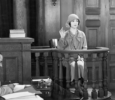My friend, Rick Kraemer owns Executive Presentations which creates graphics, animations and more for attorneys. He works with some of the most successful attorneys in the U.S. and they are not afraid to invest big dollars in his work product. Why? Because it’s wickedly effective at trial as evidenced by the amount of repeat business he gets.
Rick is smart enough to know that demonstrative evidence and cool technology in the courtroom can’t replace good lawyering. But they might be redefining what good lawyering looks like in court. We all know that a picture is worth a thousand words. Images can capture emotions and the essence of a subject in a way that words simply cannot. The power of visual media to convey messages quickly and effectively is an asset in medical-related cases. And you, as the Certified Legal Nurse Consultant, play a role in helping attorneys design and develop demonstrative evidence.
If jurors have to turn off their phones, they at least expect to be entertained. The absence of high quality demonstrative evidence can create the appearance of a digital divide. Not only is it uncool, but it reinforces the message that the attorney is not up-to-speed with the times, thus creating an advantage for the tech-savvy attorney.
Rick understood the importance of entertainment when he started his company four decades ago. Get in front of the tech-curve with demonstrative evidence and, like Rick, you’ll see the payoff for your legal nurse consulting business.
In this blog I asked five Certified Legal Nurse Consultants to share their strategies for helping attorneys with demonstrative evidence.
What Specific Role Do You Play as the Certified Legal Nurse Consultant in Helping Attorneys with Demonstrative Evidence?
“I have collaborated with my attorney-clients to create demonstrative evidence relevant to specific clinical issues that will be raised at trial. I select key records and documents to support the attorney’s case. I then place the documents in the correct sequence, which helps to elicit organized expert witness testimony and helps the attorney to more effectively cross-examine the opposing testifying experts. I also review each expert’s deposition testimony prior to trial so the documents can be organized accordingly.”
– Suzanne Arragg, RN, BSN, CDONA/LTC, CLNC
“When I assist attorneys with demonstrative evidence, I start out by conceptualizing how the jurors could best visualize the details of the case and stay focused on the timing of events and relevant issues. This visualization could be anything from detailed diagrams of organs in the body, to an enlarged linear timeline. It could also include drug details with explanations of complications. I’ve also had specialists reconstruct traffic accident scenes with cars, motorcycles, bikes, trains and buses. I always make suggestions to the attorney and establish a budget for the project before proceeding.”
– Dale Barnes, RN, MSN, PHN, CLNC
“I assist my attorney-clients with demonstrative evidence by brainstorming concepts and key issues, participating in plan development and addressing the demonstrative evidence required to support the case and testimony. I compile data and determine the relevant visuals and technology to use. I help select formats such as graphs, clocks representing time, timelines with pictures to show relevant events in a sequence and information compiled of patients before and after incidents.”
– Shequita Moore, RN, MSN, LNFA, CLNC
“My primary roles include coordinator, collaborator, proofreader and liaison with the testifying experts. Per the direction of the attorney, I initiate correspondence, produce documents and provide follow-up with the graphic designer to ensure the successful completion of the visuals. Once the visuals are completed and approved by the attorney, I obtain written approval from the experts who will be using the demonstrative evidence.”
– Lori Sprenger, PhD, RN, CLNC
“I help attorneys to capitalize on both the primacy effect and recency effect with demonstrative evidence. When first presenting a case to jurors, introducing demonstrative evidence early increases the jurors’ memory recall because learners are more likely to remember the items they learn first (primacy effect). Bringing the jury’s attention to the demonstrative evidence again at the end of the trial maximizes recall of important points because learners remember items learned at the end of a learning session best (recency effect).”
– Susan Thibeault, RN, DNAP, MBA, CRNA, APRN, EMT-P, CLNC
Principles of Conceptualizing and Developing Demonstrative Evidence.
- Appeal to the senses. The purpose of demonstrative evidence is to illustrate key issues, help the jury better understand the key issues and to provide the facts of the case within the context of a timeline or story. Demonstrative evidence can be visual, auditory and/or kinesthetic. Demonstrative evidence must be relevant and accurate. Appealing to different senses provides a better context of the facts of the case. The jury will remember visuals better than just hearing about the issues.
- Brainstorm with the attorney on the best way to demonstrate key points and the media to be used for demonstrative evidence. Certain messages are best displayed as a checklist, others as a 3D model or video animation. There is no one size fits all for demonstrative evidence. Be open to new ideas and do not be afraid to go beyond the typical poster strategy. Brainstorm with the attorney to ensure the exhibits are jury friendly. Demonstrative evidence should simplify complex clinical issues and be easily understood.
- Assess courtroom capabilities and budget prior to assisting with demonstrative evidence. This ensures the plan aligns with the available courtroom technology and the attorney’s budget.
Examples of Demonstrative Evidence
- “A Definition of Terms exhibit (in alphabetical order), which includes terms the experts, witnesses and attorneys will use during trial. For example, with facet joint syndrome, the jury needs to understand what vertebrae are, how they are connected and the conditions that cause the pain such as degenerative disc disease and/or spondylolisthesis. A graphic or model of the vertebra could also be used to demonstrate a normal vertebral facet joint versus one that is inflamed, disrupted or shows spondylolisthesis.”
- “In a motor vehicle accident (MVA) personal injury case, where timing of the events is of the essence, graphics would be effective in showing the progression of the key events of the MVA. An animation could effectively recreate the accident. I consulted on a truck driving accident case in which the trucker (plaintiff) suffered injuries that exacerbated his prior cervical neck condition. The case was mediated, settled and did not go to trial. Demonstrative evidence for depositions included 2D visuals of the cervical spine and models of the head/neck/spine so that opposing counsel and representatives of the insurance company could visualize the extent of the plaintiff’s cervical disc injuries pre- and post-incident and appreciate how the incident significantly compounded his condition to the point where surgery and long-term rehabilitation were required.
I also consulted on a medical malpractice case of a plaintiff who suffered cervical injuries in an MVA and subsequently experienced complications from surgery that caused long-term cognitive impairments. Models were used to show the anatomy of the cervical spine. An animation recreated the details, specifically showing how deviations from the standards of care occurred during surgery.”
- “In an elder abuse case, the plaintiff alleged two nursing homes neglected the resident. The resident had more than 30 comorbidities. Each was defined in layman’s terms. In addition, demonstrative evidence was created to show all daily care that was provided for four consecutive months. 6×6 foot calendars on poster board displayed icons representing aspects of daily care/life, such as doctor’s visits, family visits, medication, bathing, eating, mobility and activity participation. The result was impressive to the jury, and the case was ultimately defended on all claims.”
- “A Day in the Life video can be used to address the plaintiff’s condition before and after the incident. The plaintiff and family are interviewed to tell their story. Hearing the plaintiff and family members speak is a way to prove the negative impact the incident has had on the everyday life of the plaintiff and family.”
- “I assisted in the development of demonstrative evidence in a case where a resident sustained multiple head injuries after a fall, which included a subdural hematoma and intraventricular and subarachnoid brain bleeds. The demonstrative evidence was designed to give the audience a visual picture of the function of the brain and what happened to the brain after the resident sustained the head injuries. The attorney utilized a timeline of events with clock pictographs, a slide show of the chambers of the brain and what happened when the resident sustained a blow to his head, pathophysiology of a subdural hematoma, intraventricular bleed and subarachnoid hemorrhage and a synopsis of the damages caused by the blow to his head. The resident involved in this case expired as a result of the head injuries. The demonstrative evidence was very effective in assisting the jury to understand the complex medical issues of the case.”
– Shequita Moore, RN, MSN, LNFA, CLNC
– Suzanne Arragg, RN, BSN, CDONA/LTC, CLNC
– Lori Sprenger, PhD, RN, CLNC
– Suzanne Arragg, RN, BSN, CDONA/LTC, CLNC
– Lori Sprenger, PhD, RN, CLNC
How to Interface with Litigation Graphic Designers
Collaborating with the graphic designers is imperative to ensure they have everything they need to plan and develop demonstrative evidence. The Certified Legal Nurse Consultants should use these strategies for interfacing with the litigation graphic designers:
- Encourage the attorney to engage the litigation graphic designers early in the process. Suzanne Arragg, RN, BSN, CDONA/LTC, CLNC shares, “On one case the attorney brought the litigation graphic designers in too late. There were time constraints that limited their ability to produce the type of demonstrative evidence we were seeking.”
- Communicate case facts and expectations. Dale Barnes, RN, MSN, PHN, CLNC states, “Communication is the most important factor. If I’m working on an MVA case I give the graphic designer the details of the accident and ensure they have pertinent medical records and police reports. I make sure they know exactly what the attorney is requesting. I have them explain their concept to me to make sure our ideas match. Sometimes they will even suggest something I did not think of. If I like the idea, I will discuss it with the attorney, including the price.”
Shequita Moore, RN, MSN, LNFA, CLNC adds, “I educate the graphic designer on medical aspects and key points of the case. I utilize my clinical expertise to assist in determining how to effectively present the information. We collaborate on formats, color schemes, font and font sizes and any additional items that will affect the presentation. I help to ensure that the information presented is relevant and accurate. Additionally, I consider how the opposition will present their key points.”
Susan Thibeault, RN, DNAP, MBA, CRNA, APRN, EMT-P, CLNC suggests, “A successful collaboration is where the final work product clearly communicates the message that is desired to the jury in an effective manner.”
Common Mistakes Attorneys Make When Using Demonstrative Evidence
- Not allowing sufficient time to prepare the exhibit and not including the consulting expert in the process.
- Not being clear on the budget or not allocating a sufficient budget for demonstrative evidence. Dale Barnes, RN, MSN, PHN, CLNC shares, “In one case the attorney opted not to use demonstrative evidence because he thought it was too expensive. The jury got bogged down in a lot of technical jargon they did not comprehend and the attorney lost the case. In contrast, the times the attorneys have had the most effective demonstrative evidence, they have won. One example involved a motorcycle accident in which the attorney had the scene reconstructed. The jury could clearly see the angle at which the motorcyclist was hit (while riding in his own lane without excessive speed or lane changes). Then they could see visually how the rider landed in the street. This was far more effective than a verbal description.
A second example involved a psychiatric patient who was on a 72 hour hold. He managed to pry open barred windows and jump from a floor high up. He did not survive, but the enlarged photos and copy of the codes for a psychiatric facility in that city showed clear evidence that the window bars were not to code and that the patient was not properly monitored. I am certain the demonstrative evidence was a factor in both verdicts.”
- Demonstrative evidence that is too complicated, chaotic, busy or hard to read. This decreases the effectiveness of the information being presented and distracts from the presentation of the case. Susan Thibeault, RN, DNAP, MBA, CRNA, APRN, EMT-P, CLNC adds, “An exhibit should be easy to read and understand. It should be very clear what the take home point of the message is. The font size and color scheme should make the image easy to read from across the room. If it cannot be read or visualized well, then the whole point is lost.”
- Content errors and misspelling of words reduce the effectiveness of demonstrative evidence. This is where the Certified Legal Nurse Consultant can come in handy – checking all demonstrative evidence for accuracy.
- Not maximizing the use of technology in the courtroom or not assessing in advance for technology capabilities in the courtroom. Technology plays an increasingly important role in the courtroom. It allows demonstrative evidence to be presented in an innovative and professional way. Technology is easy to operate and the visibility can be adjusted and read from across the courtroom.
Susan Thibeault, RN, DNAP, MBA, CRNA, APRN, EMT-P, CLNC describes, “Video presentations where 3D models are dissected and show normal anatomy, and then the anatomy of the injured plaintiff, are absolutely fascinating and attention-getting. Any juror can grasp the issue with the use of such a powerful visual aid. With the increased use of technology, social media, and instant gratification that the internet provides, the attention span of the average juror is limited. Technology can be used to wake up a jury that can become easily bored after listening to hours of testimony. A video or multi-media presentation is sure to capture their attention no matter how complex or dry the information being presented is.”
Lori Sprenger, PhD, RN, CLNC cautions, “Technology is an attorney’s best friend until it’s not. That is why an IT support person is needed in the courtroom to make sure everything runs smoothly with a minimum amount of disruption and to troubleshoot as necessary.”
- Not having a low tech back-up plan for all types of demonstrative evidence that rely on technology. Susan Thibeault, RN, DNAP, MBA, CRNA, APRN, EMT-P, CLNC advises, “There should always be a printed poster on a poster board with an easel. Printed handouts should be available to reinforce any concepts should a technology failure occur.”
More and more the courtroom is a home theatre of sorts (without the popcorn). You may not know how to get the popcorn into the courtroom, but you can at least help to make the case interesting to the jury and even flush out the ADHD that is becoming epidemic among jurors.
Thanks to Suzanne Arragg, RN, BSN, CDONA/LTC, CLNC, Dale Barnes, RN, MSN, PHN, CLNC, Shequita Moore, RN, MSN, LNFA, CLNC, Lori Sprenger, PhD, RN, CLNC and Susan Thibeault, RN, DNAP, MBA, CRNA, APRN, EMT-P, CLNC for sharing their strategies for helping attorneys with demonstrative evidence.
Success Is Yours,
P.S. Comment here and share how you help your attorney-clients with demonstrative evidence.









A timeline created on Lexis Nexis Litigation support called “Case Map” easily creates the best factual visual. It is truthful and accurate. Combined with a PowerPoint, it can empower a judge and jury with the evidence to opine on standard of care and to depict the information most relevant to the case.